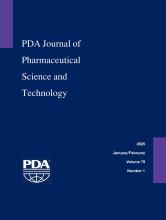Abstract
Elastomeric components such as closures and stoppers play key roles in providing container closure integrity (CCI), supporting a portfolio of injectable combination products and primary containers including needle shields (NS) in prefilled syringes (PFS). Upon piercing through elastomeric (i.e., synthetic rubber) components, the physical interaction between the needle and deformable elastomer could result in the formation of small, random-shaped particles fragmented and dislodged from the NS material due to cutting processes. This phenomenon, called coring, poses a major risk in drug product contamination as elastomer particle fragments can potentially be aspirated with the medication and injected into a patient or prevent injection. Here, we present a combined computational and experimental approach to assess the incidence of coring. In particular, we first experimentally characterized the non-linear finite deformation behavior of five commonly used NS elastomers and calibrated constitutive models. Then, we performed finite element simulations validated with needle insertion experiments to compare the coring behavior of the NS elastomers. We demonstrated that higher maximum failure strain under tension and higher deformation-stiffening properties of the elastomer are contributing factors that attenuate coring and fragmentation. The experimental-numerical framework presented is suitable for quantifying broad correlative and discovering relationships between device properties governing the incidence of coring and fragmentation.
- Received December 23, 2024.
- Accepted March 12, 2025.
- Copyright © 2025, Parenteral Drug Association
PDA members receive access to all articles published in the current year and previous volume year. Institutional subscribers received access to all content. Log in below to receive access to this article if you are either of these.
If you are neither or you are a PDA member trying to access an article outside of your membership license, then you must purchase access to this article (below). If you do not have a username or password for JPST, you will be required to create an account prior to purchasing.
Full issue PDFs are for PDA members only.
Note to pda.org users
The PDA and PDA bookstore websites (www.pda.org and www.pda.org/bookstore) are separate websites from the PDA JPST website. When you first join PDA, your initial UserID and Password are sent to HighWirePress to create your PDA JPST account. Subsequent UserrID and Password changes required at the PDA websites will not pass on to PDA JPST and vice versa. If you forget your PDA JPST UserID and/or Password, you can request help to retrieve UserID and reset Password below.






